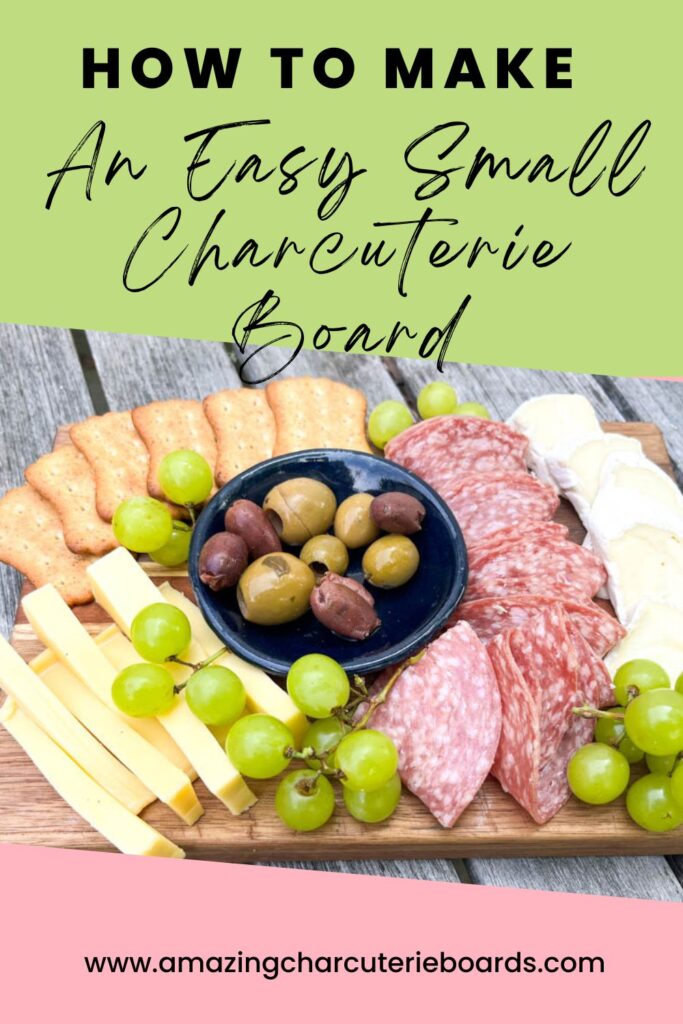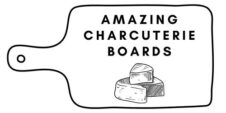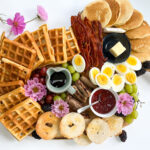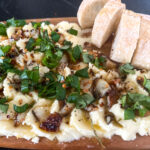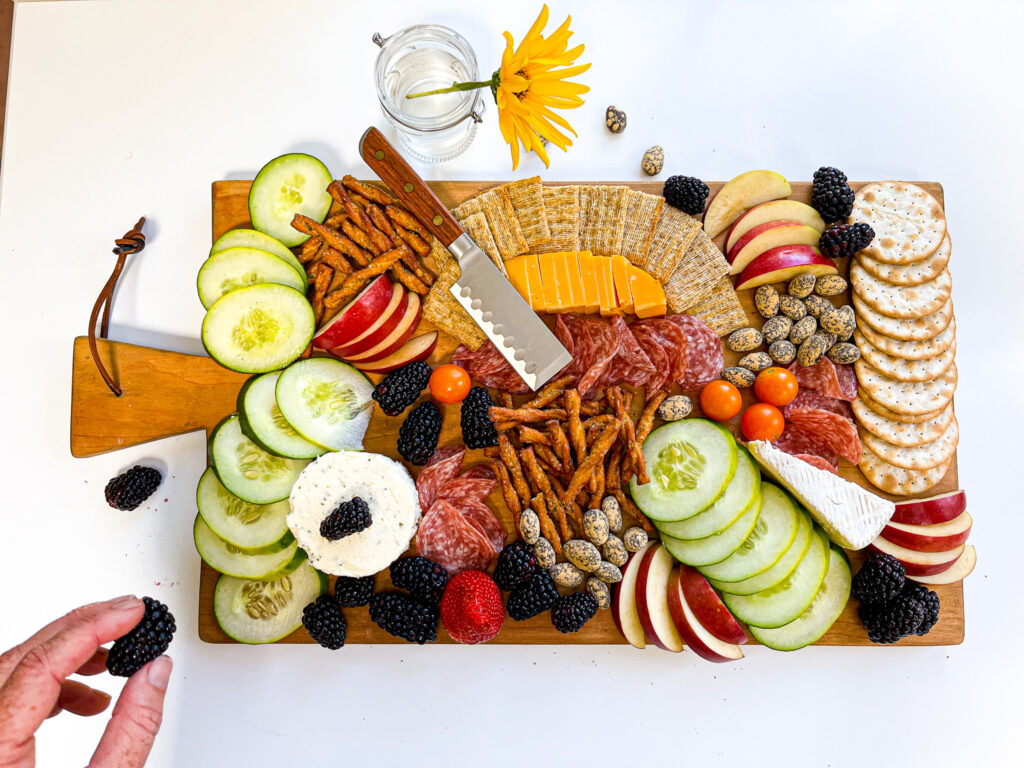A Charcuterie board doesn’t need to be large and complicated. With just a few ingredients and some creative design, you can make an easy small charcuterie board perfect for a snack or an appetizer. I created this board as s simple pre-dinner snack for our family of 5 and it was just enough to tide us over for dinner without ruining the meal!
Below you can see exactly what ingredients to use and the simple steps to assemble your own easy small charcuterie board.
Looking for charcuterie board inspiration? Check out our More Charcuterie Board Ideas.
This post may include affiliate links. When you purchase items from these links, we will receive a small commission, at no extra cost to you, to help support this website.

Contents
What is a Charcuterie Board
Before we launch into how to assemble an easy small charcuterie board, it’s helpful to know exactly what you are making.
Traditionally, a charcuterie board was made primarily of cured meats with a few additional items like cheese and bread. Over the years, the history and meaning of a charcuterie board has broadened. Today, a charcuterie board can be almost any assortment of ingredients laid out on a board or platter. Many charcuterie board include crackers, cheese, nuts, fruit, vegetable, pickles, chocolate and more.
Steps for Making an Easy Small Charcuterie Board
Making a small charcuterie board doesn’t need to be complicated – in fact many easy charcuterie boards can be made with just a few ingredients that you already have in your home. Creating a simple charcuterie board is a great last minute option. Below you can see the exact steps to help you create the perfect small board.
Select the Perfect Board
It all starts with the perfect board.
Since the focus here is on keeping it easy – start with what you have already in your home. Choose a small cutting board, charcuterie board, plate, platter or tray.
If you don’t already have a small charcuterie board, you can often find boards at your local home goods store or even your grocery store. You can also find small charcuterie boards online – look for boards between 10-20 inches in length and remember that measurements often include handles. You can see some of our favorite charcuterie boards on our shop page.
Select the Ingredients
Delicious ingredients are what set a charcuterie board apart. You can create a charcuterie board shopping list, or simply look for ingredients you already have at home. Choose a range of ingredients including different colors, textures, shapes and sizes to make your board interesting. Cut your ingredients into bite-sized pieces or serve with a knife to make it easy to eat.
Below we will share the basic ingredients to include on a charcuterie board. If you want to dig deeper check out the best charcuterie board ingredients to use to make the perfect board.
*An easy small charcuterie board is so easy to customize – below you can find suggestions for ingredients, but this board is easy to customize – if you are vegetarian, leave out the meat, if you can’t to dairy – skip the cheese, or if you are gluten free – choose gluten free crackers.
Start with the Meat
Cured meats generally serves as the foundation of the charcuterie board. Select one or more options of sliced and cured meats. You can include options such as:
- Ham (Prosciutto, Pancetta, Speck)
- Cured Sausage (peperoni)
- Meat Pate
- Salami
- Lard
- Smoked Meats
- Fish
See more about choosing the best meat for a charcuterie board.
Lay your meat on the board in row or slices on the board. If you are using thinly sliced meats you can fold or roll them into creative shapes and designs. Try making a meat rose or other statement item with the meat.
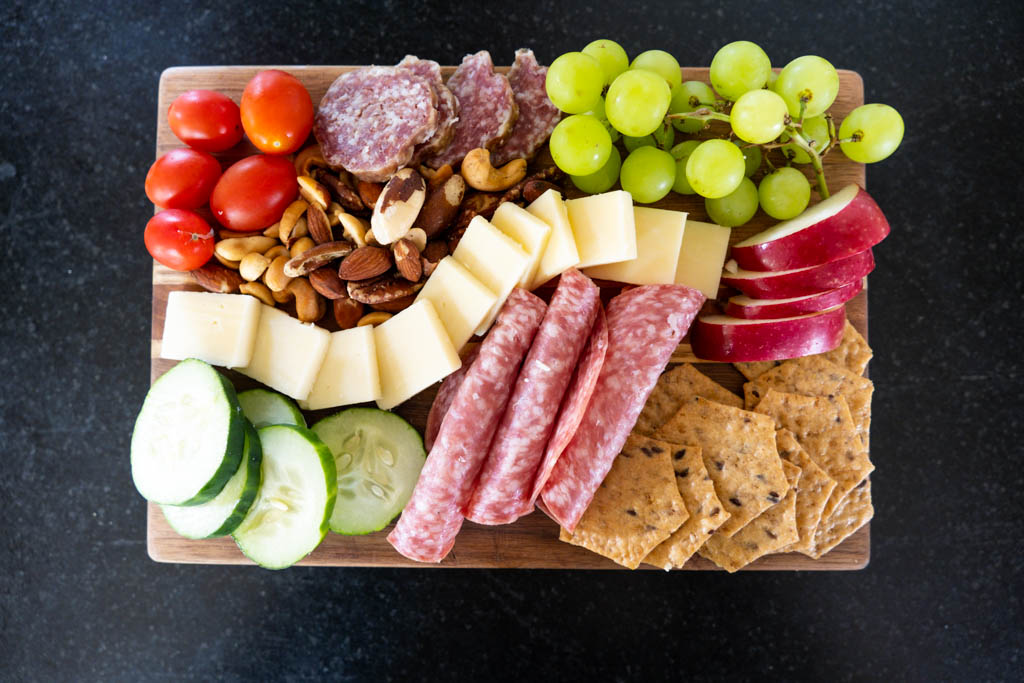
Add the Cheese
Cheese is the other main ingredient that is almost always found on the charcuterie board. Select cheese that you already have at your home or buy one or two types of cheese. Some of our favorite charcuterie board cheese includes: brie, cheddar, gouda, mozzarella and goat cheese.
See more about the best cheese for a charcuterie board.
To serve the cheese, slices the cheese and place it in rows or groups on the charcuterie board. Most cheese is white colored and makes a distinct element on the board and can be used to separate other ingredients. I like to lay cheese in curved rows to add an interesting element to the board. In general 1-2 types of cheese work well to make an easy small charcuterie board.
Add Fruits and Vegetables
Once you have your cheese and meat on the board, choose a few fruits or vegetables to add something sweet, crunchy, and colorful to your board. You can choose items that go well with the cheese and meat (like apples) or something that can be eaten and enjoyed on its own (like carrots).
Fruits and vegetables are often the most interesting items on a charcuterie board and can be cut in a variety of patterns and slices. Get creative and lay your vegetables and fruits in rows, clusters, arcs, or even in a small bowl on the board itself. Some vegetables in particular pair well with dips and you can serve you dip on the board or in a small bowl alongside the bowl.
Add your Grains
Serving your charcuterie board with some type of grain (like crackers or bread). Many of these items are often large to fit on a small charcuterie board, so another option is to serve them in a small bowl alongside the board itself. If you do plan to serve them directly on the board, lay them in rows or groups on the board. Since these items tend to soak up any moisture, keep them away from wet ingredients you might have on the board (like tomatoes).
Finish off with Specialty Ingredients
Once you have your core ingredients served up on your easy small charcuterie board, you can add a few specialty ingredients. Choose your favorite small snacks to add – if you are making this at home, just choose what you have otherwise you can shop for items such as:
- pickles
- nuts
- chocolate
- olives
- small baked goods
- dried fruit
- hard boiled eggs
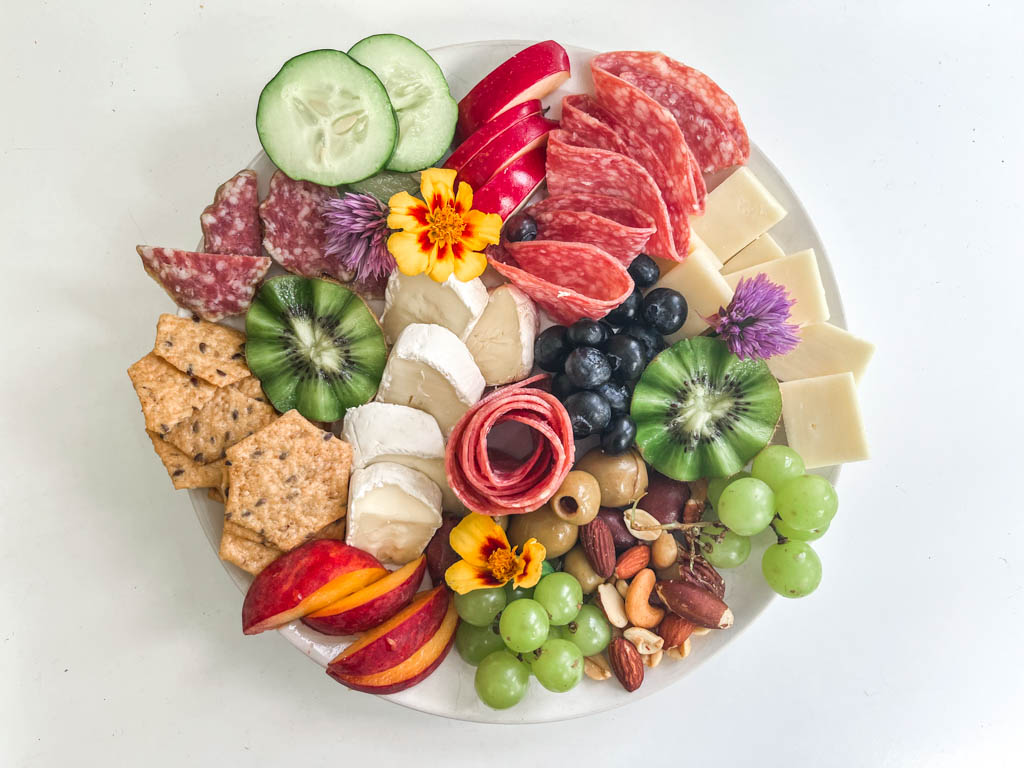
Optional Finish Off with a Garnish
To add a final element to your easy small charcuterie board, consider adding a few garnishes. These can include edible flowers, herbs, labels, or other elements to add just a bit more to your charcuterie board. Since this is a small plate you only need one or two items to make it beautiful.
See more about how to garnish a charcuterie board.
Tips for Assembling the Charcuterie Board
To summarize the best way to assemble an easy small charcuterie board, follow these steps:
- Balance a variety of flavors by including a combination of salty cured meats, creamy cheeses, tangy pickles, and sweet fruits on your small charcuterie board.
- Create visual appeal by arranging your charcuterie board with a mix of colors and textures, placing different elements next to each other for an aesthetically pleasing presentation.
- Use a mix of crunchy and soft accompaniments such as crusty bread, crispy crackers, and buttery olives to add interesting textures to your charcuterie board.
- Incorporate fresh herbs, like basil or rosemary, for an aromatic touch that enhances the overall taste and adds a pop of green to your board.
- Keep it simple and organized by using small bowls or ramekins to contain spreads, dips, or sauces, preventing them from spreading onto other ingredients and ensuring easy access for your guests.

How to Serve a Charcuterie Board
Once you’ve assembled you easy small charcuterie board you should plan to serve the board immediately. If you don’t have grain (bread and crackers) on the board, you can also put it in the fridge for a short time. Below are some general tips on serving your small charcuterie board.
First, pair the charcuterie board with appropriate beverages such as a light red wine, a crisp white wine, or even a refreshing craft beer. These pairings can elevate the flavors and create a well-rounded tasting experience. Second, provide cheese knives, toothpicks, or small tongs for easy serving, allowing guests to effortlessly select their desired items. This way, everyone can enjoy the charcuterie board without any fuss or mess.
Take the opportunity to educate your guests about the ingredients on the charcuterie board. Share interesting tidbits about the cured meats, cheeses, and accompaniments. Encourage your guests to explore and try new combinations. Highlight the unique flavors and textures, fostering a sense of culinary adventure and discovery. By sharing knowledge and promoting exploration, you can create an engaging and interactive charcuterie experience. You can use labels to help with this.
To ensure everyone gets to enjoy the charcuterie board, it’s important to manage portion sizes and replenish as needed. Keep an eye on the popular items and make sure they are adequately stocked. It’s better to have smaller portions that can be refilled promptly rather than large quantities that may go to waste. By monitoring and replenishing the board as necessary, you’ll ensure a constant flow of delectable bites throughout the gathering. This is less important with a small board, but I like to have a bit extra on hand if folks are still hungry.
If there are any leftovers from your small charcuterie board, it’s important to handle them properly to maintain freshness and safety. Place any perishable items, such as cheeses or meats, back into the refrigerator promptly. Wrap them tightly to prevent drying out or absorbing unwanted odors. Use airtight containers or food-grade wraps to preserve their quality.
Summary of How to Create an Easy Small Charcuterie Board
Small charcuterie boards make the perfect addition to a cocktail party, picnic, or before dinner snack and they only take a few minutes to assemble. Get creative and add you favorite ingredients to make a perfect board to share with friends and family.
